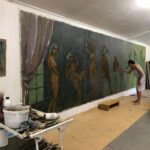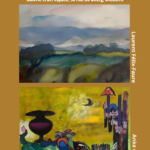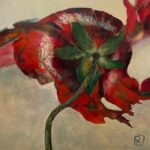Fiona McClean – Turning Poetry Into Painting
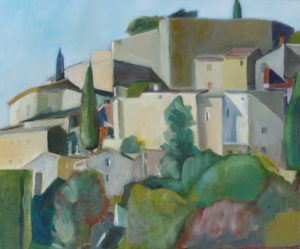
CREST AND ITS TOWER
From whichever side you come as you approach Crest (8000 inhabitants) the first thing that meets the eye is a high square tower at the top of a hill overlooking a cluster of old houses with pink rooftops. Aesthetically there is nothing especially remarkable about the “Tour de Crest” except that it resembles a 52 metres high shoebox,* standing up against the sky and that it claims to be the tallest keep in France. However, from a historical point of view the tower has many stories to tell.
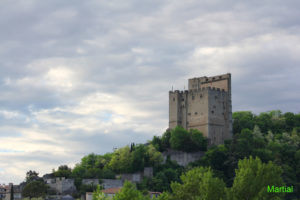 It was built in the 12th century on the remnants of a 10th century castle. During the Middle Ages Crest was at the heart of violent conflicts between lords vying for its possession before becoming the property of the Kingdom of France in the 15th century. It was then granted by the Crown to several families, notably to the Cesar Borgia and to Diane de Poitiers the famous and very influential mistress of King Henri II. In 1642 King Louis XIII conceded the Duchy of Valentinois that included Crest to the Grimaldi family, the princes of Monaco and remained in their hands until 1798 during the French Revolution. They actively contributed to the development and maintenance of the village and its fortifications but the destiny of the tower took a completely different turn. From then onwards it served as a prison for protestants during the wars of religion in the 17th century, for prisoners of common law and political prisoners. Today, the hundreds of graffiti that cover the walls – drawings, dates, signatures and texts – are moving reminders of the time spent by these prisoners in jail, of their hopes, their sufferings and distress. There is a debate as to the origin of the name of Crest. The most appealing and poetical one has it that Crest comes from the Latin and is indicative of the “comb” of a bird! From afar, the medieval village seems to creep up to this strange creature which is reached by way of narrow snaking lanes. At the bottom flows the Drôme River from which the Department derives its name.
It was built in the 12th century on the remnants of a 10th century castle. During the Middle Ages Crest was at the heart of violent conflicts between lords vying for its possession before becoming the property of the Kingdom of France in the 15th century. It was then granted by the Crown to several families, notably to the Cesar Borgia and to Diane de Poitiers the famous and very influential mistress of King Henri II. In 1642 King Louis XIII conceded the Duchy of Valentinois that included Crest to the Grimaldi family, the princes of Monaco and remained in their hands until 1798 during the French Revolution. They actively contributed to the development and maintenance of the village and its fortifications but the destiny of the tower took a completely different turn. From then onwards it served as a prison for protestants during the wars of religion in the 17th century, for prisoners of common law and political prisoners. Today, the hundreds of graffiti that cover the walls – drawings, dates, signatures and texts – are moving reminders of the time spent by these prisoners in jail, of their hopes, their sufferings and distress. There is a debate as to the origin of the name of Crest. The most appealing and poetical one has it that Crest comes from the Latin and is indicative of the “comb” of a bird! From afar, the medieval village seems to creep up to this strange creature which is reached by way of narrow snaking lanes. At the bottom flows the Drôme River from which the Department derives its name.
 Fiona McClean who is English is not the first artist to settle in Crest. For many years it was the hometown of the well known painter Albert Voisin (1905 – 1994) or Vanber as he used to sign his works. Along with internationally well known colleagues such as André Lhote, Sonia Delaunay, Albert Gleizes who were his friends, he formed an active group within the Cubist movement. They also participated in the Salon Art et Jeunesse of which he was a co-founder in Crest. Vanber has left an important body of work made up of figurative and abstract brightly coloured oils and gouaches, as well as remarkable collages in which he pasted all sorts of materials including torn off shreds of city posters. His work can be found in the Museum of Valence. The artistic tradition of Crest is upheld today by 4 galleries: the Centre d’Art Crest, the Galerie Espace Liberté , the Galerie Duvert and the Galerie Girouette as well as by artists like Fiona Mcclean who have chosen to live here.
Fiona McClean who is English is not the first artist to settle in Crest. For many years it was the hometown of the well known painter Albert Voisin (1905 – 1994) or Vanber as he used to sign his works. Along with internationally well known colleagues such as André Lhote, Sonia Delaunay, Albert Gleizes who were his friends, he formed an active group within the Cubist movement. They also participated in the Salon Art et Jeunesse of which he was a co-founder in Crest. Vanber has left an important body of work made up of figurative and abstract brightly coloured oils and gouaches, as well as remarkable collages in which he pasted all sorts of materials including torn off shreds of city posters. His work can be found in the Museum of Valence. The artistic tradition of Crest is upheld today by 4 galleries: the Centre d’Art Crest, the Galerie Espace Liberté , the Galerie Duvert and the Galerie Girouette as well as by artists like Fiona Mcclean who have chosen to live here.
*A subjective and personal impression!
FIONA McCLEAN
A work of art can take the onlooker by surprise and even come as a shock when it unexpectedly reflects a sub-conscious emotion of joy, fear, compassion, tenderness or horror. Artists are all familiar with the experience of a visitor in a gallery or in their studio stopping before one of their works and wanting to have it at all costs. There is quite obviously something more at play here than aesthetics only which seems to point to the recognition of something intimate the onlooker wants to hold on to. The well known English art critic Kenneth Clark once wrote “…that non material values can be discovered in visible things….I believe that the majority of people really long to experience that moment of pure disinterested non-material satisfaction which causes them to ejaculate the word beautiful, and the experience can be obtained more reliably through art than any other means.”
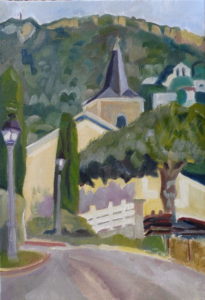 Fiona McClean is an accomplished traditional artist, who has the right eye for the big picture without losing sight of details. She also has a subtle and delicate sense of colour and all the other attributes of a skilled professional. But her drawings and paintings have more to them than that. They capture the essence of her subjects which is perhaps the reason why on seeing them the sense of recognition is so strong.
Fiona McClean is an accomplished traditional artist, who has the right eye for the big picture without losing sight of details. She also has a subtle and delicate sense of colour and all the other attributes of a skilled professional. But her drawings and paintings have more to them than that. They capture the essence of her subjects which is perhaps the reason why on seeing them the sense of recognition is so strong.
Who is Fiona McClean? Finding out more about who an artist is and what the motivations are that have led him or her to make art is always interesting and thought-provoking. It also provides for a better understanding of how he or she deals with the business of combining art and living. Fiona McClean has kindly agreed to answer the following questions.
When did you decide to become an artist and why?
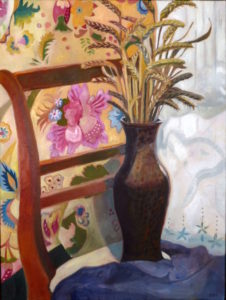 I loved drawing and painting at school and was encouraged by my art teacher and parents. My teacher often set up an unusual still life, for example he brought into the classroom a stuffed ptarmigan (a species of bird) which challenged and inspired me. The story my teacher told me of the life of Van Gogh stayed with me and later inspired the idea in me of becoming a painter.
I loved drawing and painting at school and was encouraged by my art teacher and parents. My teacher often set up an unusual still life, for example he brought into the classroom a stuffed ptarmigan (a species of bird) which challenged and inspired me. The story my teacher told me of the life of Van Gogh stayed with me and later inspired the idea in me of becoming a painter.
During periods of illness painting and drawing have helped me to concentrate and focus. They are two activities which transform my feelings and thoughts into a painting which I can share and enjoy.
How did you learn to paint?
I studied art during a period where conceptual art was considered more important than figurative art. I was encouraged by my tutor to stop painting and to write instead, as I had shown an interest in writing. I produced performances based on the short plays I wrote. But after university I felt the urge to get back to doing what I loved which was painting.
I met a painter who was to become a friend and teacher. In return for assistance in his painting workshops I was given materials and the freedom to paint again and was able to join in the painting and drawing classes he gave. This paradise lasted a year. I also took a part-time adult education course in fine art painting and attended many more classes and life drawing sessions but most of all I learnt painting by doing as much as possible.
Did you start exhibiting early?
 I didn’t start exhibiting until I was in my thirties. At the time I was supporting myself by working for a charity as a graphic designer. With continuing health problems painting would become even more important to me. The discoveries of medication fortunately lead to an increased output of painting. I was in heaven again. After exhibiting wherever I could find space albeit in a barn or a chapel I decided to take my portfolio around London and find a gallery. The first gallery which accepted me was The New Grafton Gallery where I exhibited regularly for eight years until moving to France. I was also taken on by another Gallery which gave me my first solo show.
I didn’t start exhibiting until I was in my thirties. At the time I was supporting myself by working for a charity as a graphic designer. With continuing health problems painting would become even more important to me. The discoveries of medication fortunately lead to an increased output of painting. I was in heaven again. After exhibiting wherever I could find space albeit in a barn or a chapel I decided to take my portfolio around London and find a gallery. The first gallery which accepted me was The New Grafton Gallery where I exhibited regularly for eight years until moving to France. I was also taken on by another Gallery which gave me my first solo show.
You are a writer; do you feel that there is interplay between both means of expression?
When aged about 21 I consciously made a decision I would one day write a novel. During the three years when I stopped painting in 2011 and turned to writing, I wrote two novels. Writing and painting were not compatible. I could not do one while doing the other! Although my writing is very visual in my use of metaphors, the two activities competed. After completing the novels I returned to painting again. During this period my mother passed away. She was a very creative person who made extremely detailed embroidery and paintings. My mother was a devoted follower of my exhibitions and she would often buy a painting without me knowing until later. When she died my manner of painting changed from semi figurative to figurative and I started a series based on chairs and interiors.
How do you work?
My subject matter is what I am experiencing, whether it is the interiors I visit or the landscapes I see. I feel I need to record and share that experience.
I often draw studies of the subject before painting it. Drawing allows me to quickly capture the light and the image. It also helps me to decide on the composition. I draw in pencil on a variety of papers when working on interiors and with paint and a fine brush when working with landscapes.
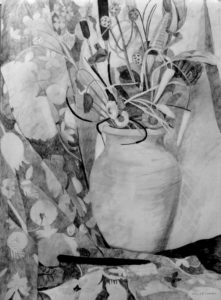

Oil paints are my favourite medium because they dry slowly and allow me to work on the painting for several weeks. Although I try to paint the colours I see in front of me, my use of colour and contrast can be arbitrary so that I can express myself more forcefully.
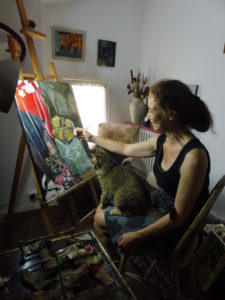 I often work with my cat on my lap listening to music, in the attic of our house. As there is very little light I use daylight bulbs. I work as often as I can and create projects to motivate me. I challenge myself each time choosing a subject which is different to the last and often more complex requiring further drawing. Usually I work on one painting at a time but more recently I have worked on two or three paintings, moving from one to the other.
I often work with my cat on my lap listening to music, in the attic of our house. As there is very little light I use daylight bulbs. I work as often as I can and create projects to motivate me. I challenge myself each time choosing a subject which is different to the last and often more complex requiring further drawing. Usually I work on one painting at a time but more recently I have worked on two or three paintings, moving from one to the other.
What does painting mean to you?
Painting is as essential as a breath of air. I often feel it has the benefits of meditation enabling me to focus. But it also enables me to express complex experiences and emotions.
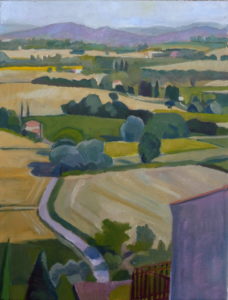
Important moments
-For a while I worked in a hospital in Oxford with people challenged with a physical disability enabling them to channel their creativity and find means of exhibiting their work.
-Having a painting accepted for exhibition at the Salon d’Automne in Paris in 2016 came as a surprise and put me on an enormous high for quite some time. It was lovely to share this experience with my husband as we carried this large painting by train and metro and taxi to the Champ Elysées!
-I am presently preparing for a solo exhibition which will take place in September 2019 at the Centre d’Art, Espace Chabrillan, Montélimar
Posted in: Art
